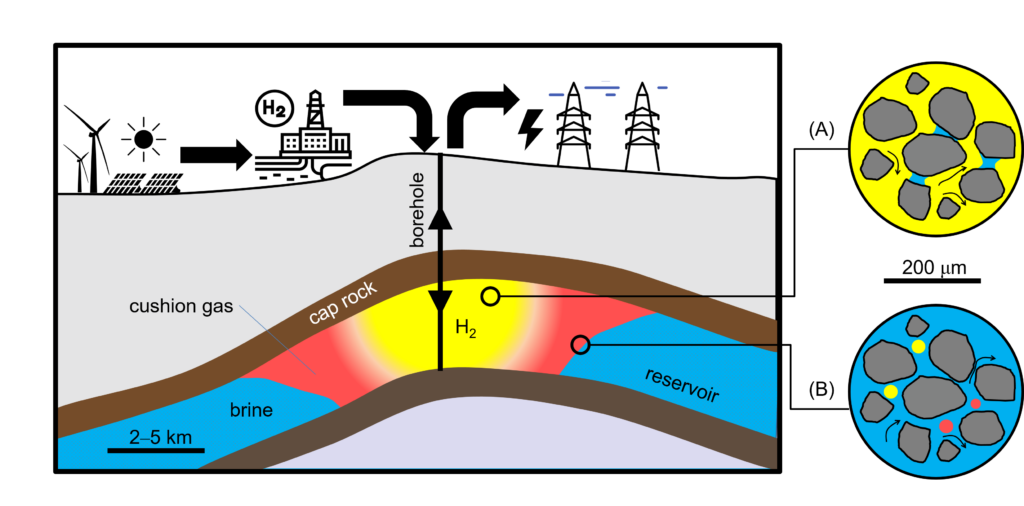The potential storage capacity of hydrogen in the subsurface – e.g. in depleted oil and gas reservoirs, deep saline aquifers – is very large and can be used for underground hydrogen storage. While one can transfer know-how and technology from natural gas storage and underground carbon storage, some of the challenges underground hydrogen storage faces are different. Compared to subsurface water, hydrogen has a very low density and viscosity. Consequently, a hydrogen plume will experience strong buoyancy forces (i.e. high leakage potential). In addition, water upconing towards the extraction borehole can occur. This could lead to the influx of water into the borehole. Further, some stored hydrogen will remain underground, trapped by capillary forces. The cyclic injection/extraction process leads to a constant alternation between drainage (gas displaces water) and imbibition (water displaces gas), potentially increasing the trapping of hydrogen. These research topics are being investigated with the aid of numerical simulations at the Chair of Hydromechanics.

The conceptual illustration shows a H2 plume in an underground reservoir. The diagrams (A) and (B) show the fluid distribution in the pores at different locations. (A) Ideally, the H2 plume displaces most or all of the mobile formation water. (B) H2 bubbles are trapped and immobilised by capillary forces.
Funding: Internal funding of chair; since 01.08.2021
Researcher: Diya Sunil Kumbhat; PI: Anozie Ebigbo
Project publications:
- Diya Sunil Kumbhat and Anozie Ebigbo (2024) Effect of relative permeability hysteresis on plume dynamics, wellbore flow regime, and storage efficiency in underground hydrogen storage, International Journal of Hydrogen Energy, 91, 243–255.
Project-related presentations:
- Kumbhat D.S.: Effect of geological heterogeneities on underground hydrogen storage operations. Poster presentation at the Bergen Conference on Modelling and Simulation of Coupled Subsurface Dynamics, May 2025, Bergen, Norway.
- Kumbhat, D. S.: Impact of relative permeability hysteresis on underground hydrogen storage plume dynamics. Oral presentation at Computational Methods in Water Resources conference, October 2024, Tucson, Arizona.
- Ebigbo A.: Relative permeability hysteresis in underground hydrogen storage – a look at the finer details. Keynote lecture at the Second Symposium of the West Africa InterPore Chapter, July 2024, online.
- Kumbhat, D. S.: Impact of Relative Permeability Hysteresis on Underground Hydrogen Storage, Oral presentation at Energy & Mobility Colloquium, November 2023, Helmut Schmidt University, Hamburg, Germany.
- Kumbhat, D. S.: Impact of Relative Permeability Hysteresis on Underground Hydrogen Storage. Poster presentation at the 15th Annual Meeting of InterPore, May 2023, Edinburgh, Scotland.

Letzte Änderung: 8. July 2025